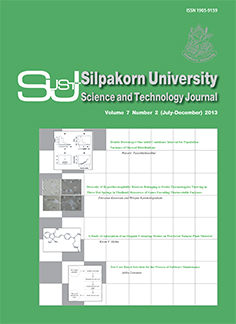Double Bootstrap-t One-sided Confidence Interval for Population Variance of Skewed Distributions
Main Article Content
Abstract
This paper proposes a double bootstrap-t one-sided confidence interval for population variance of skewed distributions. The upper endpoint and lower endpoint confidence intervals are studied. The one-sided confidence intervals based on the chi-square statistic, bootstrap-t method and double bootstrap-t method are compared via Monte Carlo simulations. The simulation results indicated that the coverage probabilities of bootstrap-t confidence interval can be increased by using double bootstrap resampling. The upper endpoint confidence interval using double bootstrap-t method predominates the other methods with respect to the coverage probability criteria. The performance of the proposed one-sided confidence interval is illustrated with an empirical example.
Downloads
Article Details
References
Casella, G. and Berger, R. L. (2001). Statistical Inference. Duxbury Press, Pacific Grove, pp.257.
Cojbasic, V. and Loncar, D. (2011). One-sided confidence intervals for population variances of skewed distribution. Journal of Statistical Planning and Inference, 141(5): 1667-1672.
Cojbasic, V. and Tomovic, A. (2007). Nonparametric confidence intervals for population variances of one sample and the difference of variances of two samples. Computational Statistics & Data Analysis, 51(12): 5562-5578.
Efron, B. (1979). Bootstrap methods: Another look at the jackknife. Annals of Statistics, 7(1): 1-26.
Efron, B. and Tibshirani, R. J. (1993). An Introduction to the Bootstrap. Chapman & Hall, New York.
Hall, P. (1986). On the bootstrap and confidence intervals. Annals of Statistics, 14(4): 1431-1452.
Ihaka, R. and Gentleman, R. (1996). “R: A Language for Data Analysis and Graphics.” Journal of Computational and Graphical Statistics, 5: 299-314.
Nankervis, J. C. (2002). Stopping rules for double bootstrap confidence intervals, [Online URL: www.citeseerx.ist.psu.edu/viewdoc/download?doi=10.1.1.86.8480&rep=rep1&type=pdf] accessed on November 19, 2012.
Nankervis, J. C. (2005). Computational algorithms for double bootstrap confidence intervals. Computational Statistics & Data Analysis, 49(2): 461-475.
Pearson, K. (1900). On the criterion that a given system of deviations from the probable in the case of a correlated system of variables is such that it can be reasonably supported to have arisen from random sampling. Philosophical Magazine, 50(5): 157-175.
Scherer, B. and Martin, R. D. (2005). Introduction to Modern Portfolio Optimization with NUOPT and S-PLUS. Springer, New York.
Tosasukul, J., Budsaba, K., and Volodin, A. (2009). Dependent bootstrap confidence intervals for a population mean. Thailand Statistician, 7(1): 43-51.


